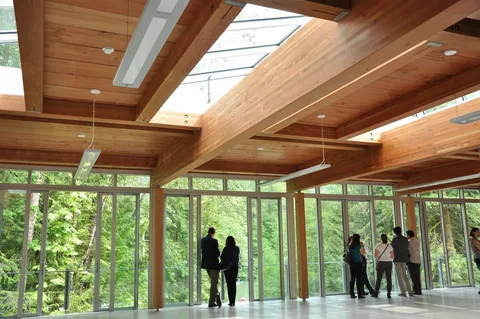In the realm of sustainable architecture and construction, Cross Laminated Timber (CLT) has emerged as a game-changing material. With its unique properties and environmentally friendly characteristics, CLT is revolutionizing the way we approach design and construction. This blog delves into the world of CLT design, uncovering its benefits, applications, and the creative possibilities it offers to architects, engineers, and builders.
The Basics of CLT
Cross Laminated Timber, often referred to as CLT, is a structural engineered wood product made by stacking layers of lumber at right angles and bonding them together with adhesives. These layers are known as lamellas and are typically 3, 5, or 7 layers thick. The alternating grain directions in each layer lend exceptional strength and stability to CLT panels, allowing them to bear heavy loads with ease.
Benefits of CLT Design
Sustainability: One of the most significant advantages of CLT is its eco-friendliness. Wood is a renewable resource, and using CLT promotes sustainable forestry practices. Additionally, the manufacturing process of CLT requires less energy and produces fewer carbon emissions compared to traditional construction materials like concrete and steel.
Strength and Stability: Despite its lightweight nature, CLT panels exhibit remarkable strength and stability. This makes CLT an ideal choice for both residential and commercial buildings, including mid-rise and even high-rise structures. Its dimensional stability also minimizes warping, shrinking, and swelling.
Speed and Efficiency: CLT panels are prefabricated off-site, allowing for rapid construction and reduced on-site labor requirements. This not only accelerates project timelines but also helps to mitigate the disruptions associated with traditional construction methods.
Design Flexibility: CLT offers unparalleled design flexibility, enabling architects and designers to create innovative and imaginative structures. Its ability to span long distances allows for open and adaptable interior spaces, making it a sought-after material for modern and sustainable design concepts.
Seismic Performance: CLT exhibits excellent seismic performance due to its lightweight nature and the inherent elasticity of wood. This makes it a reliable choice for buildings located in earthquake-prone regions.
Creative Applications
The versatility of CLT design is showcased in a myriad of applications:
Residential Construction: CLT is increasingly being used for single-family homes, multi-family dwellings, and housing complexes. Its thermal insulation properties contribute to energy-efficient homes.
Commercial Buildings: From offices to educational institutions, CLT is revolutionizing the construction of commercial spaces. Its aesthetic appeal and quick assembly are particularly attractive for such projects.
Cultural and Community Spaces: CLT's warm aesthetic and acoustic properties make it an excellent choice for theaters, community centers, and cultural venues. The material's natural beauty can enhance the overall ambiance of such spaces.
Interior Design: CLT can be integrated into interior design elements, such as feature walls, ceilings, and furniture. This not only adds visual interest but also imparts a sense of connection to nature indoors.
Design Considerations
Structural Analysis: While CLT is inherently strong, proper structural analysis is crucial to ensure its performance under different loads and conditions.
Fire Protection: While wood is combustible, CLT panels can be designed with fire-resistant treatments to enhance safety.
Moisture Protection: Proper detailing and protective measures must be employed to prevent moisture infiltration, which could potentially compromise the material's integrity.
Acoustic Performance: While CLT provides some natural sound insulation, supplementary acoustic treatments may be necessary for specific applications.
Conclusion
Cross Laminated Timber design is rewriting the rulebook of sustainable construction. Its blend of strength, eco-friendliness, and design flexibility is making waves in the architecture and engineering communities. As we continue to seek innovative solutions for the challenges of modern construction, CLT stands as a testament to the remarkable potential of natural materials. Whether crafting sustainable homes, awe-inspiring commercial spaces, or inviting interiors, CLT is undeniably at the forefront of 21st-century design.


No comments yet